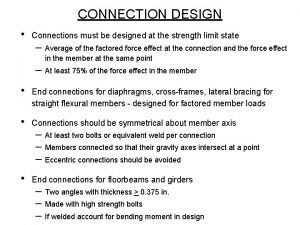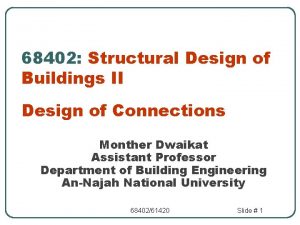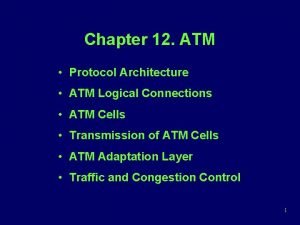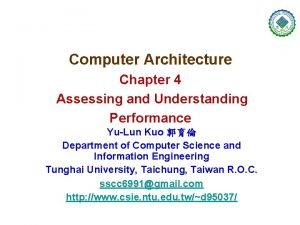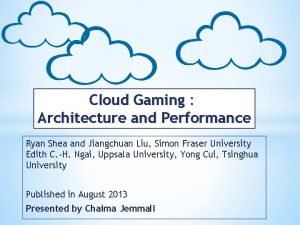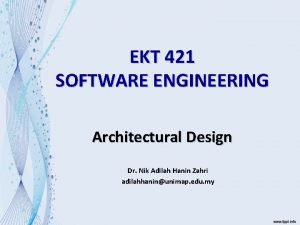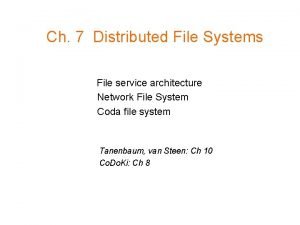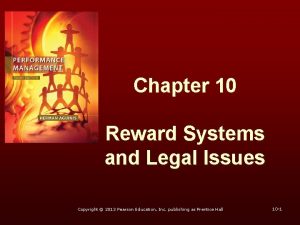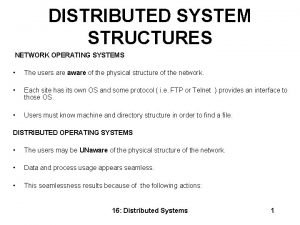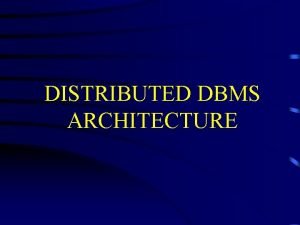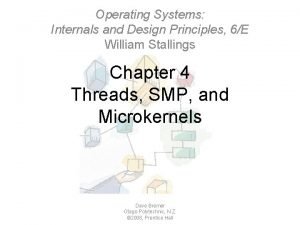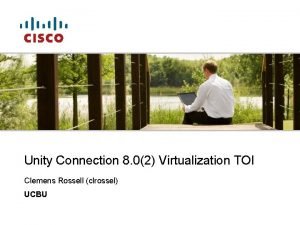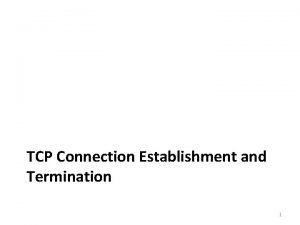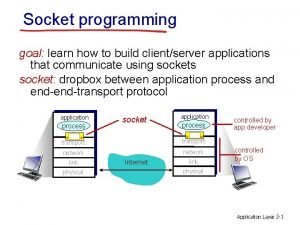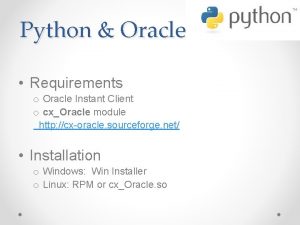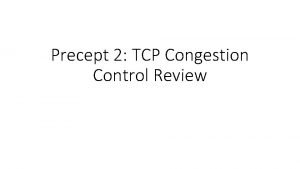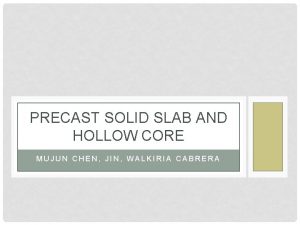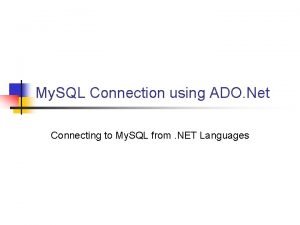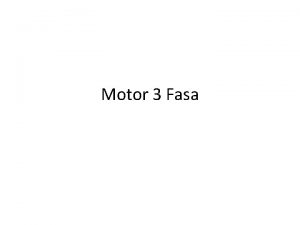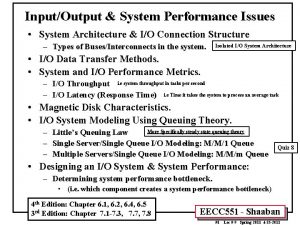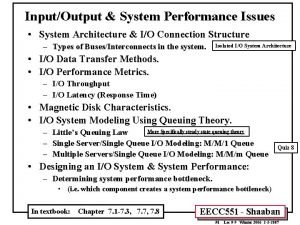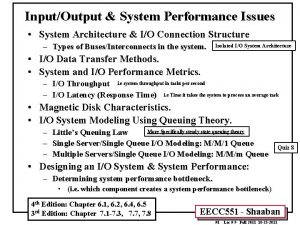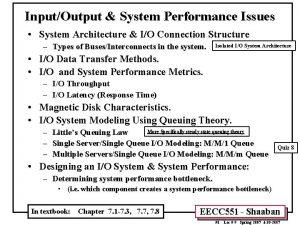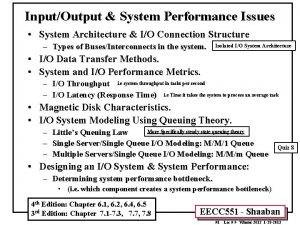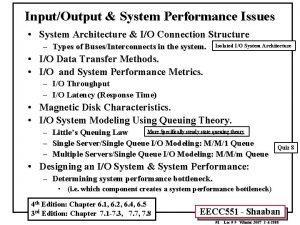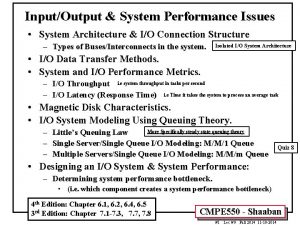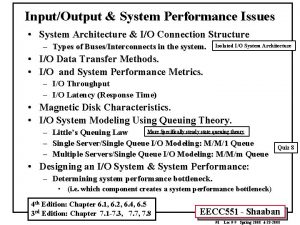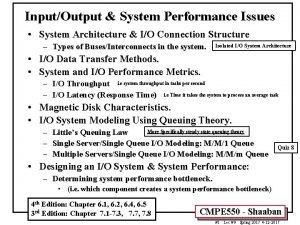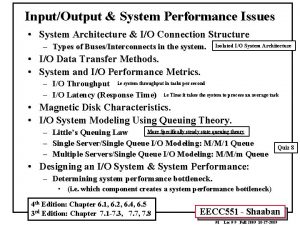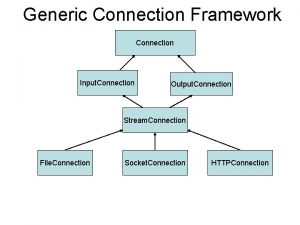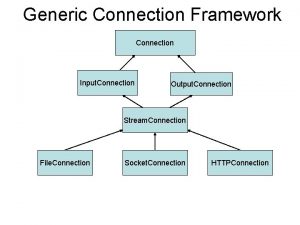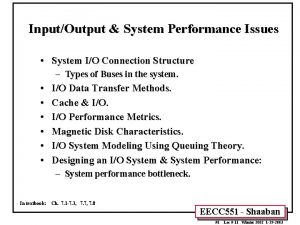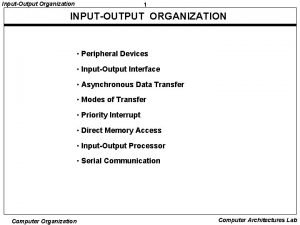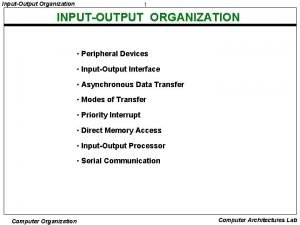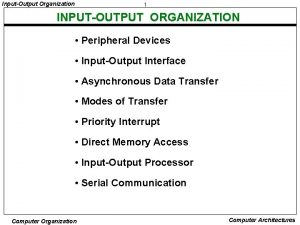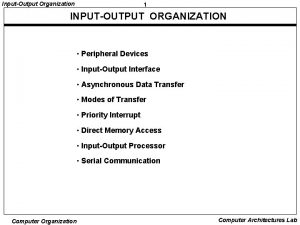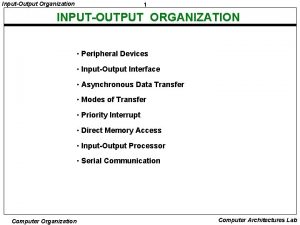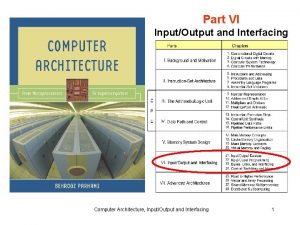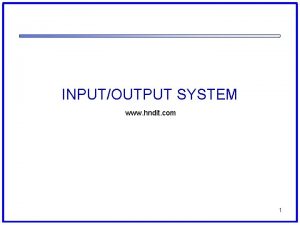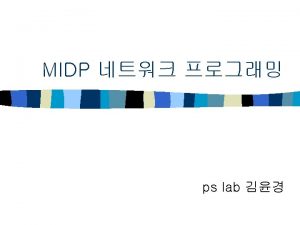InputOutput System Performance Issues System Architecture IO Connection












































- Slides: 44

Input/Output & System Performance Issues • System Architecture & I/O Connection Structure – Types of Buses/Interconnects in the system. Isolated I/O System Architecture • I/O Data Transfer Methods. • System and I/O Performance Metrics. – I/O Throughput i. e system throughput in tasks per second – I/O Latency (Response Time) i. e Time it takes the system to process an average task • Magnetic Disk Characteristics. • I/O System Modeling Using Queuing Theory. – – – More Specifically steady state queuing theory Little’s Queuing Law Single Server/Single Queue I/O Modeling: M/M/1 Queue Multiple Servers/Single Queue I/O Modeling: M/M/m Queue Quiz 8 • Designing an I/O System & System Performance: – Determining system performance bottleneck. • (i. e. which component creates a system performance bottleneck) 4 th Edition: Chapter 6. 1, 6. 2, 6. 4, 6. 5 3 rd Edition: Chapter 7. 1 -7. 3, 7. 7, 7. 8 EECC 551 - Shaaban #1 Lec # 9 Winter 2009 2 -1 -2010

The Von-Neumann Computer Model • Partitioning of the computing engine into components: 1 2 3 – Central Processing Unit (CPU): Control Unit (instruction decode, sequencing of operations), Datapath (registers, arithmetic and logic unit, buses). Memory: Instruction (program) and operand (data) storage. Input/Output (I/O): Communication between the CPU/memory and the outside world. – – System Architecture = System components and how the components are connected (system interconnects) Components of Total System Execution Time: (or response time) Control 2 CPU Memory Input Computer System I/O Subsystem Datapath registers ALU, buses 1 CPU System Interconnects Memory (instructions, data) I/O System performance depends on many aspects of the system (“limited by weakest link in the chain”): The system performance bottleneck 3 Output I/O Devices EECC 551 - Shaaban #2 Lec # 9 Winter 2009 2 -1 -2010

Input and Output (I/O) Subsystem • The I/O subsystem provides the mechanism for communication between the CPU and the outside world Including memory (I/O devices). Including users • Design factors: – I/O device characteristics (input, output, storage, etc. ) /Performance. – I/O Connection Structure (degree of separation from Isolated I/O System Architecture memory operations). – I/O interface (the utilization of dedicated I/O and bus controllers). – Types of buses/system interconnects (processor-memory vs. I/O buses/interconnects). – I/O data transfer or synchronization method (programmed I/O, interrupt-driven, DMA). Components of Total System Execution Time: (or response time) CPU Memory I/O EECC 551 - Shaaban #3 Lec # 9 Winter 2009 2 -1 -2010

Typical System Architecture = System Components + System Component Interconnects System Bus or Front Side Bus (FSB) Microprocessor Chip Back Side Bus (BSB) System Interconnects: 1 - (CPU-Memory System Interconnect) Memory Controller (Chipset North Bridge) (One or more levels) I/O Controller Hub (Chipset South Bridge) i. e. System Core Logic Isolated I/O System Interconnects: 2 - (I/O System Interconnect) Current System Architecture: Isolated I/O: Separate memory (system) and I/O buses. Thus I/O Subsystem Two Types of System Interconnects/Buses: 1 - CPU-Memory Bus or interconnect 2 – I/O Buses/interfaces EECC 551 - Shaaban #4 Lec # 9 Winter 2009 2 -1 -2010

Typical Mainstream System Architecture CPU Core 1 GHz - 3. 8 GHz 4 -way Superscaler RISC or RISC-core (x 86): Deep Instruction Pipelines Dynamic scheduling Multiple FP, integer FUs Dynamic branch prediction Hardware speculation SDRAM (possibly PC 100/PC 133 on-chip) 100 -133 MHz 64 -128 bits wide 2 -way inteleaved ~ 900 MBYTES/SEC )64 bit) Double Date Rate (DDR) SDRAM PC 3200 MHz DDR 64 -128 bits wide 4 -way interleaved ~3. 2 GBYTES/SEC (64 bit) System Architecture = System Components + System Component Interconnects L 1 CPU L 2 All Non-blocking caches L 1 16 -128 K 1 -2 way set associative (on chip), separate or unified L 2 256 K- 2 M 4 -32 way set associative (on chip) unified L 3 2 -16 M 8 -32 way set associative (on or off chip) unified L 3 Front Side Bus Caches (FSB) System Bus Adapter Memory Controller Memory Bus Memory RAMbus DRAM (RDRAM) Chipset 400 MHZ DDR 16 bits wide (32 banks) North ~ 1. 6 GBYTES/SEC (System Logic) Bridge Current System Architecture: Isolated I/O: Separate memory (system) and I/O buses. Examples: Alpha, AMD K 7: EV 6, 200 -400 MHz Intel PII, PIII: GTL+ 133 MHz Intel P 4 800 MHz Thus I/O Controllers Main I/O Bus NICs Disks Displays Keyboards Chipset Example: PCI, 33 -66 MHz 32 -64 bits wide 133 -528 MB/s PCI-X 133 MHz 64 -bits wide 1066 MB/s Networks I/O Devices South (System Logic) Bridge (Isolated I/O Subsystem) I/O Subsystem Two Types of System Interconnects/Buses: 1 - CPU-Memory Bus or interconnect 2 – I/O Buses/interfaces Important issue: Which component creates a system performance bottleneck? EECC 551 - Shaaban #5 Lec # 9 Winter 2009 2 -1 -2010

Main Types of Buses/Interconnects in The System 1 Processor-Memory Bus/Interconnect: AKA System Bus, Front Side Bus, (FSB) – Should offer very high-speed (bandwidth) and low latency. – Matched to the memory system performance to maximize memory-processor bandwidth. – Usually system design-specific (not an industry standard). – Examples: Alpha EV 6 (AMD K 7), Peak bandwidth = 400 MHz x 8 = 3. 2 GB/s Intel GTL+ (P 3), Peak bandwidth = 133 MHz x 8 = 1 GB/s Intel P 4, Peak bandwidth = 800 MHz x 8 = 6. 4 GB/s Hyper. Transport 2. 0: 200 Mhz-1. 4 GHz, Peak bandwidth up to 22. 8 GB/s Also Intel's Quick. Path Interconnect (QPI) (point-to-point system interconnect not a bus) used in Core i 7 system architecture 2 I/O buses/Interconnects: Sometimes called I/O channels or interfaces – Follow bus/interface industry standards. – Usually formed by I/O interface adapters to handle many types of connected I/O devices. – Wide range in the data bandwidth and latency – Not usually interfaced directly to memory instead connected to processormemory bus via a bus adapter (system chipset south bridge). Isolated I/O System Architecture – Examples: Main system I/O bus: PCI, PCI-X, PCI Express Storage Interfaces: SATA, PATA, SCSI. System Architecture = System Components + System Component Interconnects EECC 551 - Shaaban #6 Lec # 9 Winter 2009 2 -1 -2010

Intel Pentium 4 System Architecture (Using The Intel 925 Chipset) System Architecture = System Components + System Component Interconnects CPU (Including cache) System Bus (Front Side Bus, FSB) Bandwidth usually should match or exceed that of main memory System Core Logic Memory Controller Hub (Chipset North Bridge) System Memory Two 8 -byte DDR 2 Channels Graphics I/O Bus (PCI Express) Isolated I/O Storage I/O (Serial ATA) Main I/O Bus (PCI) Misc. I/O Interfaces System Core Logic I/O Controller Hub (Chipset South Bridge) Basic Input Output System (BIOS) Current System Architecture: Isolated I/O: Separate memory and I/O buses. Source: http: //www. anandtech. com/showdoc. aspx? i=2088&p=4 I/O Subsystem EECC 551 - Shaaban #7 Lec # 9 Winter 2009 2 -1 -2010

(e. g. FSB) Bus Characteristics Option High performance Low cost/performance Bus width Separate address & data lines Data width Wider is faster 64 bits) (e. g. , 16 bits) Multiplex address Narrower is cheaper (e. g. , Transfer size Multiple words has less bus overhead Bus masters Multiple (requires arbitration) Single-word transfer is simpler Single master (no arbitration) Split Yes, separate No , continuous transaction? Request and Reply connection is cheaper packets gets higher and has lower latency bandwidth (needs multiple masters) Clocking Synchronous Asynchronous FSB = Front Side Bus (Processor-memory Bus or System Bus) EECC 551 - Shaaban #8 Lec # 9 Winter 2009 2 -1 -2010

Example CPU-Memory System Buses (Front Side Buses, FSBs) Bus Summit Challenge XDBus SP Originator HP SGI Sun Clock Rate (MHz) 60 48 Split transaction? Yes Address lines P 4 IBM Intel 66 111 800 Yes Yes 48 40 ? ? Data lines 128 256 144 Clocks/transfer 4 5 4 ? ? Peak (MB/s) 960 1200 1056 1700 6400 Master Multi Arbitration Central Addressing Physical Length Multi 13 inches 12 inches 17 inches 128 Multi Central ? ? 64 Multi Central Physical ? ? FSB Bandwidth matched with single 8 -byte channel SDRAM FSB Bandwidth matched with dual channel PC 3200 DDR SDRAM EECC 551 - Shaaban #9 Lec # 9 Winter 2009 2 -1 -2010

Main System I/O Bus Example: PCI, PCI-Express Specification PCI 2. 3 Legacy PCI 2. 3 PCI-X 1. 0 Not Implemented Yet Formerly Intel’s 3 GIO PCI-X 2. 0 PCI-Express Addressing Physical Master Multi Arbitration Central Bus Width (bits) Peak Bandwidth (MB/sec) Bus Frequency (MHz) 32 33. 3 133 64 33. 3 266 64 66. 6 533 64 133. 3 1066 64 266, 533 2100 , 4200 ? ? ? 500 -16, 000 1 -32 PCI Bus Transaction Latency: PCI requires 9 cycles @ 33 Mhz (272 ns) PCI-X requires 10 cycles @ 133 MHz (75 ns) PCI = Peripheral Component Interconnect EECC 551 - Shaaban #10 Lec # 9 Winter 2009 2 -1 -2010

Storage IO Interfaces/Buses EIDE/Parallel ATA (PATA) SCSI Data Width 16 bits 8 or 16 bits (wide) Clock Rate Upto 100 MHz 10 MHz (Fast) 20 MHz (Ultra) 40 MHz (Ultra 2) 80 MHz (Ultra 3) 160 MHz (Ultra 4) Bus Masters 1 Multiple Max no. devices 2 7 (8 -bit bus) 15 (16 -bit bus) Peak Bandwidth 200 MB/s 320 MB/s (Ultra 4) Target Application Desktop EIDE = Enhanced Integrated Drive Electronics ATA = Advanced Technology Attachment PATA = Parallel ATA SATA = Serial ATA Servers SCSI = Small Computer System Interface EECC 551 - Shaaban #11 Lec # 9 Winter 2009 2 -1 -2010

I/O Data Transfer Methods 1 • Programmed I/O (PIO): Polling (For low-speed I/O) – – – 2 The I/O device puts its status information in a status register. The processor must periodically check the status register. The processor is totally in control and does all the work. Very wasteful of processor time. Used for low-speed I/O devices (mice, keyboards etc. ) Memory-mapped register • Interrupt-Driven I/O (For medium-speed I/O): – An interrupt line from the I/O device to the CPU is used to generate an I/O interrupt indicating that the I/O device needs CPU attention. (e. g data is ready) – The interrupting device places its identity in an interrupt vector. – Once an I/O interrupt is detected the current instruction is completed an I/O interrupt handling routine (by OS) is executed to service the device. – Used for moderate speed I/O (optical drives, storage, neworks. . ) – Allows overlap of CPU processing time and I/O processing time Time(workload) = Time(CPU) + Time(I/O) - Time(Overlap) I/O No overlap I/O I/O Overlap of CPU processing Time and I/O processing time EECC 551 - Shaaban #12 Lec # 9 Winter 2009 2 -1 -2010

I/O data transfer methods: 3 Direct Memory Access (DMA) (For high-speed I/O): • Implemented with a specialized controller that transfers data between an I/O device and memory independent of the processor. The DMA controller becomes the bus master and directs reads and writes between itself and memory. Interrupts are still used only on completion of the transfer or when an error occurs. Low CPU overhead, used in high speed I/O (storage, network interfaces) Allows more overlap of CPU processing time and I/O processing time than interrupt-driven I/O. • • • DMA transfer steps: 1 2 3 – The CPU sets up DMA by supplying device identity, operation, memory address of source and destination of data, the number of bytes to be transferred. – The DMA controller starts the operation. When the data is available it transfers the data, including generating memory addresses for data to be transferred. – Once the DMA transfer is complete, the controller interrupts the processor, which determines whether the entire operation is complete. EECC 551 - Shaaban #13 Lec # 9 Winter 2009 2 -1 -2010

I/O Interface/Controller I/O Interface, I/O controller or I/O bus adapter: – Specific to each type of I/O device/interface standard. – To the CPU, and I/O device, it consists of a set of control and data registers (usually memory-mapped) within the I/O address space. – On the I/O device side, it forms a localized I/O bus which can be shared by several I/O devices • (e. g IDE, SCSI, USB. . . ) Why? Industry-standard interfaces – Handles I/O details (originally done by CPU) such as: Low-level I/O Processing off-loaded from CPU • • Assembling bits into words, Low-level error detection and correction Accepting or providing words in word-sized I/O registers. Presents a uniform interface to the CPU regardless of I/O device. EECC 551 - Shaaban #14 Lec # 9 Winter 2009 2 -1 -2010

I/O Controller Architecture Part of System Core Logic Chipset North Bridge Part of System Core Logic Peripheral or Main I/O Bus (PCI, PCI-X, etc. ) Peripheral Bus Interface/DMA Host Memory FSB Chipset South Bridge Micro-controller or Embedded processor Front Side Bus (FSB) Buffer Memory CPU-Memory Interconnect (Bus) µProcessor Cache ROM Host Processor I/O Channel Interface I/O Devices Time(workload) = Time(CPU) + Time(I/O) - Time(Overlap) I/O Controller SCSI, IDE, USB, …. Industry-standard interfaces I/O No overlap I/O I/O Overlap of CPU processing Time and I/O processing time EECC 551 - Shaaban #15 Lec # 9 Winter 2009 2 -1 -2010

I/O: A System Performance Perspective • CPU Performance: Improvement of ~ 60% per year. i. e storage devices (hard drives) • I/O Sub-System Performance: Limited by mechanical delays (disk I/O). Improvement less than 10% per year (IO rate per sec or MB per sec). CPU Memory I/O • From Amdahl's Law: overall system speed-up is limited by the slowest component: Originally: CPU-bound If I/O is 10% of current processing time: • Increasing CPU performance by 10 times Originally: I/O = 10% I/O CPU Þ 5 times system performance increase (50% loss in performance) • Increasing CPU performance by 100 times Þ ~ 10 times system performance (90% loss of performance) CPU = 90% / 10 I/O CPU Speedup = 5. 2 I/O = 53% CPU = 47% / 10 I/O Speedup = 9. 2 I/O = 92% CPU = 8% After: I/O-bound • The I/O system performance bottleneck diminishes the benefit of faster CPUs on overall system performance. System performance depends on many aspects of the system (“limited by weakest link in the chain”): The system performance bottleneck EECC 551 - Shaaban #16 Lec # 9 Winter 2009 2 -1 -2010

System & I/O Performance Metrics/Modeling • Diversity: The variety of I/O devices that can be connected to the system. • Capacity: The maximum number of I/O devices that can be connected to the I/O Task Queue I/O Producer: system. Server: i. e I/O device I/O Performance Modeling: • i. e User, OS or CPU Tasks Producer Tasks Server (FIFO) + controller Producer/server Model of I/O: The producer (CPU, human etc. ) creates tasks to be performed and places them in a task buffer (queue); the server (I/O device or controller) takes tasks from the queue and performs them. I/O (or Entire System) Performance Metrics: 1 • I/O Throughput: The maximum data rate that can be transferred to/from an I/O device or sub-system, or the maximum number of I/O tasks or transactions completed by I/O in a certain period of time Þ Maximized when task queue is never empty (server always busy). 2 • I/O Latency or response time: The time an I/O task takes from the time it is placed in the task buffer or queue until the server (I/O system) finishes the task. Includes I/O device serice time and buffer waiting (or queuing time). Þ Minimized when task queue is always empty (no queuing time). Response Time = Service Time + Queuing Time EECC 551 - Shaaban #17 Lec # 9 Winter 2009 2 -1 -2010

System & I/O Performance Metrics: Throughput 1 • Throughput is a measure of speed—the rate at which the I/O or storage system delivers data. • I/O Throughput is measured in two ways: • I/O rate: I/O Tasks/sec – Measured in: • Accesses/second, • Transactions Per Second (TPS) or, • I/O Operations Per Second (IOPS). – I/O rate is generally used for applications where the size of each request is small, such as in transaction processing. i. e server applications 2 • Data rate, measured in bytes/second or megabytes/second (MB/s). – Data rate is generally used for applications where the size of each request is large, such as in scientific and multimedia applications. EECC 551 - Shaaban #18 Lec # 9 Winter 2009 2 -1 -2010

System & I/O Performance Metrics: Response time • Response time measures how long a storage (or I/O) system takes to process an I/O request and access data. Or entire system – I/O request latency or total processing time per I/O request. • This time can be measured in several ways. i. e. Time it takes the system to process an average task For example: – One could measure time from the user’s perspective, – the operating system’s perspective, – or the disk controller’s perspective, depending on what you view as the storage or I/O system. Is Response time always = 1 / Throughput ? I/O Request Started Initiate Request (By CPU, User or OS) Response time I/O Request Done CPU time + I/O Bus Transfer Time + Queue Time + I/O controller Time + I/O device service time +. . . The utilization of DMA and I/O device queues and multiple I/O devices servicing a queue may make throughput >> 1 / response time EECC 551 - Shaaban #19 Lec # 9 Winter 2009 2 -1 -2010

Timesystem =Time in System for a task = Response Time = Queuing Time + Service Time I/O Modeling: Modeling Producer-Server Model Time a task spends waiting in queue Producer Server Service Time per task Tser Queue wait time = Tq Task Arrival Rate, r tasks/sec I/O Tasks i. e User, OS, or CPU • Throughput: Server I/O Tasks Queue (FIFO) Server i. e I/O device + controller Shown above: Single Queue + Single Server – The number of tasks completed by the server in unit time. – In order to get the highest possible throughput: • The server should never be idle. Throughput is maximized when: • The queue should never be empty. • Response time: – Begins when a task is placed in the queue – Ends when it is completed by the server – In order to minimize the response time: • The queue should be empty (no waiting time in queue). Response Time is minimized when: • The server will be idle at times. Shown above is a (Single Queue + Single Server) Producer-Server Model EECC 551 - Shaaban #20 Lec # 9 Winter 2009 2 -1 -2010

Producer-Server Model Single Queue + Single Server User or CPU Task Arrival Rate, r Tq (FIFO) Tser I/O Tasks Response Time = Time. System = Time. Queue + Time. Server = Tq + Tser Throughput vs. Response Time I/O device + controller Queue full most of the time. More time in queue Queue almost empty most of the time Less time in queue Shown here is a (Single Queue + Single Server) Producer-Server Model Utilization AKA Loading Factor i. e Utilization = U ranges from 0 to 1 (0 % to 100%) EECC 551 - Shaaban #21 Lec # 9 Winter 2009 2 -1 -2010

I/O Performance: Performance Throughput Enhancement Tq Shown here: Two Queues + Two Servers Tser Time. Server Time. Queue I/O device + controller I/O Tasks Producer e. g CPU I/O Tasks I/O device + controller Queue Server • In general throughput can be improved by: Ignoring CPU I/O processing time and other system delays – Throwing more hardware at the problem. – Reduces load-related latency. Less queuing time • Response time is much harder to reduce. – e. g. Faster I/O device (i. e server) Response Time = Time. System = Time. Queue + Time. Server = Tq + Tser EECC 551 - Shaaban #22 Lec # 9 Winter 2009 2 -1 -2010

Storage I/O Systems: Magnetic Disks Characteristics: • • { • • (1 -5) Diameter (form factor): 1. 8 in - 3. 5 in Rotational speed: 5, 400 RPM-15, 000 RPM Tracks per surface. Sectors per track: Outer tracks contain Seek Time more sectors. Recording or Areal Density: Tracks/in X Bits/in Bits/ Inch 2 Cost Per Megabyte. Seek Time: (2 -12 ms) Current Areal Density ~ 400 Gbits / Inch 2 The time needed to move the read/write head arm. Reported values: Minimum, Maximum, Average. Rotation Latency or Delay: (2 -8 ms) Current Rotation speed Rotation The time for the requested sector to be under 7200 -15000 RPM Time the read/write head. (~ time for half a rotation) Transfer time: The time needed to transfer a sector of bits. Read/Write Seek Type of controller/interface: SCSI, EIDE (PATA, SATA) Time Head Disk Controller delay or time. Average time to access a sector of data = average seek time + average rotational delay + transfer time + disk controller overhead (ignoring queuing time) Access time = average seek time + average rotational delay EECC 551 - Shaaban #23 Lec # 9 Winter 2009 2 -1 -2010

Basic Disk Performance Example • Given the following Disk Parameters: – Average seek time is 5 ms – Disk spins at 10, 000 RPM – Transfer rate is 40 MB/sec • Controller overhead is 0. 1 ms • Assume that the disk is idle, so no queuing delay exist. • What is Average Disk read or write service time for a 500 byte (. 5 KB) Sector? Time for half a rotation Ave. seek + ave. rot delay + transfer time + controller overhead = 5 ms + 0. 5/(10000 RPM/60) + 0. 5 KB/40 MB/s + 0. 1 ms = 5 + 3 + 0. 1 = 8. 23 ms Access Time Actual time to process the disk request is greater and may include CPU I/O processing Time and queuing time Here: 1 KBytes = 103 bytes, MByte = 106 bytes, Tservice Or Tser 1 GByte = 109 bytes (Disk Service Time for this request) EECC 551 - Shaaban #24 Lec # 9 Winter 2009 2 -1 -2010

Historic Perspective of Hard Drive Characteristics Evolution: Areal Density 8. 5 Million times increase in areal density Drive areal density has increased by a factor of 8. 5 million since the first disk drive, IBM's RAMAC, was introduced in 1957. Since 1991, the rate of increase in areal density has accelerated to 60% per year, and since 1997 this rate has further accelerated to an incredible 100% per year. Current Areal Density ~ 400 Gbits / In 2 EECC 551 - Shaaban #25 Lec # 9 Winter 2009 2 -1 -2010

Historic Perspective of Hard Drive Characteristics Evolution: Internal Data Transfer Rate 100 x times increase over last 20 years Internal data transfer rate increase is influenced by the increase in areal density EECC 551 - Shaaban #26 Lec # 9 Winter 2009 2 -1 -2010

Historic Perspective of Hard Drive Characteristics Evolution: Access/Seek Time Access time = average seek time + average rotational delay Less than 3 x times improvement over 15 years! Access/Seek Time is a big factor in service(response) time for small/random disk requests. Limited improvement due to mechanical rotation speed + seek delay EECC 551 - Shaaban #27 Lec # 9 Winter 2009 2 -1 -2010

Historic Perspective of Hard Drive Characteristics Evolution: Cost Per MByte: > 100, 000 X times cost drop The price per megabyte of disk storage has been decreasing at about 40% per year based on improvements in data density, -- even faster than the price decline for flash memory chips. Recent trends in HDD price per megabyte show an even steeper reduction. Actual Current Hard Disk Storage Cost (Third Quarter 2009): 0. 0001 dollars per MByte or about 10 GBytes /Dollar EECC 551 - Shaaban #28 Lec # 9 Winter 2009 2 -1 -2010

Historic Perspective of Hard Drive Characteristics Evolution: Roadmap Current Areal Density ~ 400 Gbits / In 2 EECC 551 - Shaaban #29 Lec # 9 Winter 2009 2 -1 -2010

Introduction to Queuing Theory (Steady State) Task Arrivals r Task Departures Task Arrival Rate, r tasks/sec • Concerned with long term, steady state than in startup: – where => Arrivals = Departures Rate r Rate • Little’s Law: Lsys (length or number of tasks in system) Tsys (System Time) r (arrival rate) Mean number tasks in system = arrival rate x mean response time (Steady State) • Applies to any system in equilibrium, as long as nothing in the black box is creating or destroying tasks. EECC 551 - Shaaban #30 Lec # 9 Winter 2009 2 -1 -2010

I/O Performance & Little’s Queuing Law FIFO Task arrival rate r tasks/sec Producer: CPU OS or User Proc Tasks Tq Tasks IOC + Task Service Time Device Tser Given: An I/O system in equilibrium (input rate is equal to output rate) and: – Tser : – Tq : – Tsys : – – r : Lser : Lq : Lsys : Average time to service a task = 1/Service rate Average time per task in the queue Average time per task in the system, or the response time, Ignoring CPU processing time and other system delays the sum of Tser and Tq thus Tsys = Tser + Tq Average number of arriving tasks/sec (i. e task arrival rate) Average number of tasks in service. Average length of queue Average number of tasks in the system, the sum of L q and Lser • Little’s Law states: AKA Loading Factor server Tser Queue Tsys = Tq • System (Single Queue + Single Server) Lsys = Lq = r x Tsys (applied to system) r x Tq (applied to queue) • Server utilization = u = r / Service rate = r x Tser r = Task Arrival rate u must be between 0 and 1 otherwise there would be more tasks arriving than could be serviced Here a server is the device (i. e hard drive) and its I/O controller (IOC) EECC 551 - Shaaban #31 Lec # 9 Winter 2009 2 -1 -2010

A Little Queuing Theory Task arrival rate r tasks/sec Proc FIFO Queue Tq System (Single Queue + Single Server) server Tser IOC Task Service Time Tser Device • Server spends a variable amount of time with customers – Arithmetic mean time = m 1 = (f 1 x T 1 + f 2 x T 2 +. . . + fn x Tn) • where Ti is the time for task i and fi is the frequency of task i – variance = (f 1 x T 12 + f 2 x T 22 +. . . + fn x Tn 2) – m 12 • Must keep track of unit of measure (100 ms 2 vs. 0. 1 s 2 ) – Squared coefficient of variance: C 2 = variance/m 12 Distributions: Avg. • Unitless measure • Exponential (Poisson) distribution C 2 = 1 : most short relative to average, few others long; 90% < 2. 3 x average, 63% < average • Hypoexponential distribution C 2 < 1 : most close to average, C 2=0. 5 => 90% < 2. 0 x average, only 57% < average • Hyperexponential distribution C 2 > 1 : further from average C 2=2. 0 => 90% < 2. 8 x average, 69% < average Variance = (Standard deviation)2 EECC 551 - Shaaban #32 Lec # 9 Winter 2009 2 -1 -2010

A Little Queuing Theory System FIFO Task arrival rate r server Tser Queue Producer: CPU OS or User Proc Tasks Tsys = Tq Tasks Tq (Single Queue + Single Server) + IOC Task Service Time Tser Device Tser • Service time completions vs. waiting time for a busy server: randomly arriving task joins a queue of arbitrary length when server is busy, otherwise serviced immediately – Unlimited length queues key simplification • A single server queue: combination of a servicing facility that accommodates 1 task at a time (server) + waiting area (queue): together called a system • Server spends a variable amount of time servicing tasks, average, Timeserver Response Ignoring CPU processing time Timesystem = Timequeue + Timeserver = Tsys = Tq + Tser Time and other system delays Timequeue = Lengthqueue x Timeserver + Time for the server to complete current task = Server utilization x remaining service time of current task Lengthqueue = Arrival Rate x Timequeue (Little’s Law) We need to estimate waiting time in queue (i. e Timequeue = Tq)? Here a server is the device (i. e hard drive) and its I/O controller (IOC) The response time above does not account for other factors such as CPU time. T q? EECC 551 - Shaaban #33 Lec # 9 Winter 2009 2 -1 -2010

A Little Queuing Theory: Average Queue Wait Time Tq For Single Queue + Single Server • Calculating average wait time in queue Tq – If something at server, it takes to complete on average m 1(z) = 1/2 x Tser x (1 + C 2) – Chance server is busy = u; average delay is u x m 1(z) = 1/2 x u x Tser x (1 + C 2) – All customers in line must complete; each avg Tser Timequeue = Time for the server to complete current task + Lengthqueue x Timeserver Timequeue = Average residual service time + Lengthqueue x Timeserver Tq = u x m 1(z) + Lq x Ts er= 1/2 x u x Tser x (1 + C 2) + Lq x Ts er Tq = 1/2 x u x Ts er x (1 + C 2) + r x Tq x Ts er Tq = 1/2 x u x Ts er x (1 + C 2) + u x Tq (Rearrange) Tq x (1 – u) = Ts er x u x (1 + C 2) /2 Lq = r x Tq (Little’s Law) Tq = Ts er x u x (1 + C 2) / (2 x (1 – u)) • Notation: r Tser u Tq Lq average number of arriving tasks/second average time to service a task What if utilization u = 1 ? server utilization (0. . 1): u = r x Tser average time/request in queue average length of queue: Lq= r x Tq A version of this derivation in textbook page 385 (3 rd Edition: page 726) EECC 551 - Shaaban #34 Lec # 9 Winter 2009 2 -1 -2010

A Little Queuing Theory: M/G/1 and M/M/1 Single Queue + Single Server • Assumptions so far: – – – Arrival Distribution Service Distribution Number of Servers (i. e C =1) System in equilibrium Time between two successive task arrivals in line are random Server can start on next task immediately after prior finishes No limit to the queue: works First-In-First-Out (FIFO) Afterward, all tasks in line must complete; each avg Tser 2 2 • Described “memoryless” or Markovian request arrival (M for C 2=1 exponentially random), General service distribution (no restrictions), 1 server: M/G/1 queue • When Service times have C 2 = 1, M/M/1 queue • Tq = Tser x u x (1 + C 2) /(2 x (1 – u)) = Tser x u / (1 – u) Response Time (Tq Tser Lq u average time/task in queue) average time to service a task Average length of queue Lq = r x Tq = u 2 / (1 – u) server utilization (0. . 1): u = r x Tser Timesystem = Timequeue + Timeserver = Tsys = Tq + Tser Queuing Time, Tq (In Textbook page 726) EECC 551 - Shaaban #35 Lec # 9 Winter 2009 2 -1 -2010 Tq

Single Queue + Multiple Servers (Disks/Controllers) I/O Modeling: M/M/m Queue Arrival i. e C 2 Service Number of servers • I/O system with Markovian request arrival rate r i. e C 2 = 1 • A single queue serviced by m servers (disks + controllers) each with =1 Markovian Service rate = 1/ Tser T ser (and requests are distributed evenly among all servers) Tq = Tser x u /[m (1 – u)] where u = r x Tser / m m Tser u Tq Lq Tsys = Tser 1 Request Arrival Rate r 2 Tasks Single Queue (FIFO) number of servers average time to service a task server utilization (0. . 1): u = r x Tser / m average time/task in queue Average length of queue Lq = r x Tq + Tq Time in system (mean response time) i. e as if the m servers are a single server with an effective service time of Tser / m Tq m m servers each has service time = Tser Please Note: We will use this simplified formula for M/M/m not the book version 4 th Edition on page 388 (3 rd Edition: page 729) EECC 551 - Shaaban #36 Lec # 9 Winter 2009 2 -1 -2010

I/O Queuing Performance: An M/M/1 Example • A processor sends 40 disk I/O requests per second, requests & service are exponentially distributed, average disk service time = 20 ms • On average: – – • i. e C 2 = 1 Tser What is the disk utilization u? What is the average time spent in the queue, Tq? What is the average response time for a disk request, Tsys ? What is the number of requests in the queue Lq? In system, Lsys? We have: r Tser • r We obtain: u Tq i. e Mean Response Time Tsys Lq Lsys average number of arriving requests/second = 40 average time to service a request = 20 ms (0. 02 s) server utilization: u = r x Tser = 40/s x. 02 s = 0. 8 or 80% average time/request in queue = Tser x u / (1 – u) = 20 x 0. 8/(1 -0. 8) = 20 x 0. 8/0. 2 = 20 x 4 = 80 ms (0. 08 s) average time/request in system: Tsys = Tq + Tser= 80+ 20 = 100 ms average length of queue: Lq= r x Tq = 40/s x 0. 08 s = 3. 2 requests in queue average # tasks in system: Lsys = r x Tsys = 40/s x 0. 1 s = 4 EECC 551 - Shaaban #37 Lec # 9 Winter 2009 2 -1 -2010

I/O Queuing Performance: An M/M/1 Example • • Previous example with a faster disk with average disk service time = 10 ms The processor still sends 40 disk I/O requests per second, requests & service are exponentially distributed i. e C 2 = 1 Tser • On average: (Changed from 20 ms to 10 ms) – How utilized is the disk, u? – What is the average time spent in the queue, Tq? – What is the average response time for a disk request, Tsys ? • We have: r Tser • average number of arriving requests/second = 40 average time to service a request = 10 ms (0. 01 s) We obtain: u Tq i. e Mean Response Time server utilization: u = r x Tser = 40/s x. 01 s = 0. 4 or 40% average time/request in queue = Tser x u / (1 – u) = 10 x 0. 4/(1 -0. 4) = 10 x 0. 4/0. 6 = 6. 67 ms (0. 0067 s) Tsys average time/request in system: Tsys = Tq +Tser=10 + 6. 67 = = 16. 67 ms Response time is 100/16. 67 = 6 times faster even though the new service time is only 2 times faster due to lower queuing time. 6. 67 ms instead of 80 ms EECC 551 - Shaaban #38 Lec # 9 Winter 2009 2 -1 -2010

Factors Affecting System & I/O Performance • I/O processing computational requirements: CPU – CPU computations available for I/O operations. – Operating system I/O processing policies/routines. – I/O Data Transfer/Processing Method used. • CPU cycles needed: Polling >> Interrupt Driven > DMA • I/O Subsystem performance: I/O – – Raw performance of I/O devices (i. e magnetic disk performance). Service Time, Tser, Throughput I/O bus capabilities. I/O subsystem organization. i. e number of devices, array level. . Loading level (u) of I/O devices (queuing delay, response time). • Memory subsystem performance: Memory Tq – Available memory bandwidth for I/O operations (For DMA) • Operating System Policies: OS – File system vs. Raw I/O. – File cache size and write Policy. – File pre-fetching, etc. Components of Total System Execution Time: System performance depends on many aspects of the system (“limited by weakest link in the chain”): The system performance bottleneck CPU Memory I/O EECC 551 - Shaaban #39 Lec # 9 Winter 2009 2 -1 -2010

System Design (Including I/O) • When designing a system, the performance of the components that make it up should be balanced. • Steps for designing I/O systems are: – List types and performance of I/O devices and buses in the system – Determine target application computational & I/O demands – Determine the CPU resource demands for I/O processing • CPU clock cycles directly for I/O (e. g. initiate, interrupts, complete) • CPU clock cycles due to stalls waiting for I/O • CPU clock cycles to recover from I/O activity (e. g. , cache flush) Iterative Refinement Process – Determine memory and I/O bus resource demands – Assess the system performance of the different ways to organize i. e system configurations these devices: • For each system configuration identify which system component (CPU, memory, I/O buses, I/O devices etc. ) is the performance Iterative bottleneck. Refinement Process • Improve performance of the component that poses a system performance bottleneck System performance depends on many aspects of the system System Performance Bottleneck (“limited by weakest link in the chain”) EECC 551 - Shaaban #40 Lec # 9 Winter 2009 2 -1 -2010

Example: Determining the System Performance Bottleneck (ignoring I/O queuing delays) • Assume the following system components: – – – 500 MIPS CPU 16 -byte wide memory system with 100 ns cycle time 200 MB/sec I/O bus Main system I/O Bus 20, 20 MB/sec SCSI-2 buses, with 1 ms controller overhead 5 disks per SCSI bus: 8 ms seek, 7, 200 RPMS, 6 MB/sec (100 disks total) • Other assumptions – – – All devices/system components can be used to 100% utilization (i. e u = 1) Average I/O request size is 16 KB I/O Requests are assumed spread evenly on all disks. OS uses 10, 000 CPU instructions to process a disk I/O request Ignore disk/controller queuing delays. (i. e u = 1) (Since I/O queuing delays are ignored here 100% disk utilization is allowed) • What is the average IOPS? • What is the average I/O bandwidth? i. e I/O throughput • What is the average response time per IO operation? Here: 1 KBytes = 103 bytes, MByte = 106 bytes, 1 GByte = 109 bytes EECC 551 - Shaaban #41 Lec # 9 Winter 2009 2 -1 -2010

Example: Determining the System I/O Bottleneck (ignoring queuing delays) • The performance of I/O systems is determined by the system component with the lowest performance (the system performance bottleneck): Determining the system performance bottleneck – CPU : (500 MIPS)/(10, 000 instructions per I/O) = 50, 000 IOPS CPU time per I/O = 10, 000 / 500, 000 =. 02 ms – Main Memory : (16 bytes)/(100 ns x 16 KB per I/O) = 10, 000 IOPS Memory time per I/O = 1/10, 000 =. 1 ms Tser Throughput: – I/O bus: (200 MB/sec)/(16 KB per I/O) = 12, 500 IOPS – SCSI-2: (20 buses)/((1 ms + (16 KB)/(20 MB/sec)) per I/O) = 11, 111 IOPS SCSI bus time per I/O = 1 ms + 16/20 ms = 1. 8 ms – Disks: (100 disks)/((8 ms + 0. 5/(7200 RPMS) + (16 KB)/(6 MB/sec)) per I/O) = 6700 IOPS Tdisk = (8 ms + 0. 5/(7200 RPMS) + (16 KB)/(6 MB/sec) = 8+ 4. 2+ 2. 7 = 14. 9 ms • The disks limit the I/O performance to 6700 IOPS • The average I/O bandwidth is 6700 IOPS x (16 KB/sec) = 107. 2 MB/sec • Response Time Per I/O = Tcpu + Tmemory + Tscsi + Tdisk = =. 02 +. 1 + 1. 8 + 14. 9 = 16. 82 ms Since I/O queuing delays are ignored here 100% disk utilization is allowed Here: 1 KBytes = 10 3 bytes, MByte = 106 bytes, 1 GByte = 109 bytes EECC 551 - Shaaban #42 Lec # 9 Winter 2009 2 -1 -2010

Example: Determining the I/O Bottleneck Accounting for I/O Queue Time (M/M/m queue) • Assume the following system components: – – – 500 MIPS CPU 16 -byte wide memory system with 100 ns cycle time 200 MB/sec I/O bus Main system I/O Bus 20, 20 MB/sec SCSI-2 buses, with 1 ms controller overhead 5 disks per SCSI bus: 8 ms seek, 7, 200 RPMS, 6 MB/sec (100 disks) • Other assumptions i. e I/O throughput Here: – – Here m = 100 Thus maximum utilization of All devices used to 60% utilization (i. e u = 0. 6). any system component is fixed in question at u = 0. 6 or 60% Treat the I/O system as an M/M/m queue. I/O Requests are assumed spread evenly on all disks. Average I/O size is 16 KB – OS uses 10, 000 CPU instructions to process a disk I/O request • What is the average IOPS? What is the average bandwidth? • Average response time per IO operation? EECC 551 - Shaaban 1 KBytes = 103 bytes, MByte = 106 bytes, 1 GByte = 109 bytes #43 Lec # 9 Winter 2009 2 -1 -2010

Example: Determining the I/O Bottleneck Accounting For I/O Queue Time (M/M/m queue) • The performance of I/O systems is still determined by the system component with the lowest performance (the system performance bottleneck): Determining the system performance bottleneck – CPU : (500 MIPS)/(10, 000 instr. per I/O) x. 6 = 30, 000 IOPS CPU time per I/O = 10, 000 / 500, 000 =. 02 ms – Main Memory : (16 bytes)/(100 ns x 16 KB per I/O) x. 6 = 6, 000 IOPS Memory time per I/O = 1/10, 000 =. 1 ms – I/O bus: (200 MB/sec)/(16 KB per I/O) x. 6 = 12, 500 IOPS – SCSI-2: (20 buses)/((1 ms + (16 KB)/(20 MB/sec)) per I/O) x. 6 = 6, 666. 6 IOPS SCSI bus time per I/O = 1 ms + 16/20 ms = 1. 8 ms – Disks: (100 disks)/((8 ms + 0. 5/(7200 RPMS) + (16 KB)/(6 MB/sec)) per I/O) x. 6 = 6, 700 x. 6 = 4020 IOPS Tser = (8 ms + 0. 5/(7200 RPMS) + (16 KB)/(6 MB/sec) = 8+4. 2+2. 7 = 14. 9 ms Throughput • The disks limit the I/O performance to r = 4020 IOPS • The average I/O bandwidth is 4020 IOPS x (16 KB/sec) = 64. 3 MB/sec Using expression • Tq = Tser x u /[m (1 – u)] = 14. 9 ms x. 6 / [100 x. 4 ] =. 22 ms for Tq for M/M/m from slide 36 • Response Time = Tser + Tq+ Tcpu + Tmemory + Tscsi = Total System response time 14. 9 +. 22 +. 02 +. 1 + 1. 8 = 17. 04 ms including CPU time and other delays Here: 1 KBytes = 103 bytes, MByte = 106 bytes, 1 GByte = 109 bytes EECC 551 - Shaaban #44 Lec # 9 Winter 2009 2 -1 -2010
 Inputoutput devices
Inputoutput devices Slip critical connection vs bearing connection
Slip critical connection vs bearing connection A490n bolts
A490n bolts Slip critical bolted connection
Slip critical bolted connection Text to world connections examples
Text to world connections examples Atm cont
Atm cont Legal issues in performance appraisal
Legal issues in performance appraisal Behaviorally anchored rating scales
Behaviorally anchored rating scales Performance levels
Performance levels 2018 jcids manual
2018 jcids manual Computer architecture performance evaluation methods
Computer architecture performance evaluation methods Performance equation in computer architecture
Performance equation in computer architecture Cloud gaming architechture
Cloud gaming architechture Architecture business cycle in software architecture
Architecture business cycle in software architecture Return architecture
Return architecture Modular architecture vs integrated architecture
Modular architecture vs integrated architecture Define product architecture
Define product architecture Bus design in computer architecture
Bus design in computer architecture System architecture diagram for hospital management system
System architecture diagram for hospital management system Explain file service architecture in distributed system
Explain file service architecture in distributed system What are the design issues of distributed operating systems
What are the design issues of distributed operating systems Ethical and social issues in information system
Ethical and social issues in information system Reward system and legal issues
Reward system and legal issues What are design issues in distributed system structure
What are design issues in distributed system structure Dbms standardization are based on
Dbms standardization are based on Operating system design issues
Operating system design issues Ethics in mis
Ethics in mis List the key design issues for an smp operating system
List the key design issues for an smp operating system Fha connection
Fha connection Verizon business connection
Verizon business connection Cisco unity virtualization
Cisco unity virtualization Uml
Uml Q connection hart middle school
Q connection hart middle school The writing revolution
The writing revolution Size of tcp segment header
Size of tcp segment header Upper parts of sewing machine
Upper parts of sewing machine Connection establishment and termination in tcp
Connection establishment and termination in tcp Welcoming socket
Welcoming socket Title for relationship essay
Title for relationship essay Python oracle instant client
Python oracle instant client A tcp connection is using a window size of 10 000 bytes
A tcp connection is using a window size of 10 000 bytes Precast solid slab
Precast solid slab Cisco unity connection unified messaging troubleshooting
Cisco unity connection unified messaging troubleshooting Executereader
Executereader Sambungan delta dan bintang
Sambungan delta dan bintang

